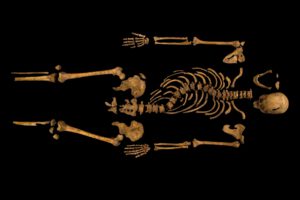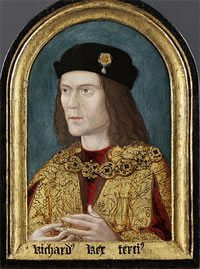Drawing on DNA analysis, genealogy, and archeology, scientists at the University of Leicester unearthed 500-year-old royal bones found under a municipal car park and have definitively identified the remains as King Richard III.

University of Leicester Photo
In their recently published findings, the team determined that the bones are indeed those of the monarch Shakespeare made infamous.
“The evidence directly indicates that these are the remains of Richard III,” says geneticist Turi King of the University of Leicester in the U.K., who led the team reporting the results in Nature Communications.
Battle of Bosworth
Much of the findings conformed to contemporary accounts of Richard III, who died at the Battle of Bosworth in 1485 – the last English monarch killed in combat. Depicted by Shakespeare as a deformed, paranoid and power-hungry villain, it’s clear that the Bard took some poetic license to characterize the king. For one, while Richard’s spine shows he clearly had scoliosis, he wasn’t a hunchback.
The car park excavation also uncovered the old tiles of the church, the Greyfriars Church, where it was said that Richard had been buried. His bones revealed more details that matched historical accounts, his curved spine, and his combat wounds. The team also looked at genetic markers in hair and 
DNA Analysis
However, DNA analysis and matching with living relatives fascinated us the most here at 23andMe.
Comparing the mitochondrial DNA from the skeletal remains to DNA from living relatives, researchers were able to make a match on Richard’s maternal line. In a mind-boggling case of finding lost relatives, they determined that one of the relatives was a niece, but 21 generations had passed. The other is a nephew, 19 generations removed. (Richard’s maternal haplogroup is J.)
However, researchers didn’t have the same luck when they compared Richard III’s DNA with living relatives on his paternal line.
The Paternal Line
Richard had no male heirs, so researchers had to trace his lineage back in time and look for a common ancestor with living relatives. They found five men who could trace their paternal line to Edward III, Richard’s great-great-grandfather, a connection that goes back 18 generations. But unlike Richard’s maternal line, the researchers didn’t find a match.

Tracing Richard III’s Paternal Line to present-day relatives.
This finding suggests that somewhere on the male line, there was a break or an illegitimate son born (a “false-paternity” event). No one knows where that might have happened in that long paternal line. It’s possible that it happened before Richard’s birth, which would cast into question the legitimacy of both Richard and his brother’s claim to the monarchy. (Richard’s paternal haplogroup is listed as G-P287.)
For 23andMe users, that is a subgroup in the G2a haplogroup.) While revelations have also triggered a flurry of stories about the legitimacy of the Tudors – the dynasty that followed Richard III after defeating him in battle – the story of Richard’s bones offers us all a rare chance to take what we know about a historical figure, use DNA and living relatives to piece together new information about the past.




